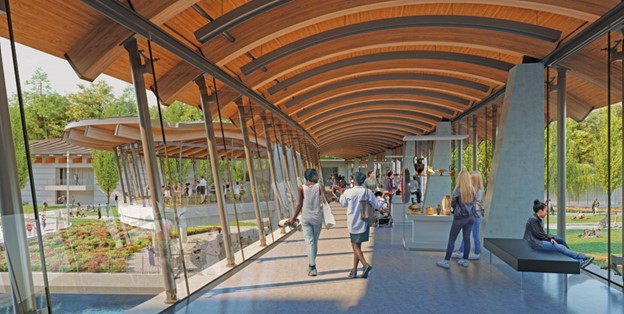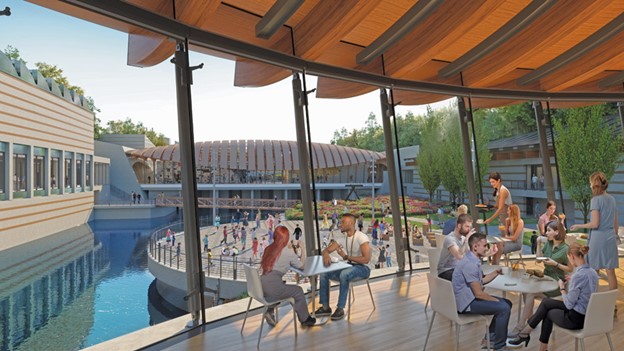

May 25, 2023
By Daniel Tyson
Contractor Flintco is moving with deliberate speed to protect the museum’s priceless art during the expansion.
Crystal Bridges Museum of American Art in Bentonville, Ark., is expanding from 100,000-sq-ft to 200,000-sq-ft. The museum houses some of the most priceless pieces of American artwork.
How does Arkansas general contractor Flintco work to construct a 100,000-sq-ft expansion of a world-class museum holding hundreds of pieces of priceless American art with daily visitors roaming the galleries?
The answer: very carefully.
The expansion of the Crystal Bridges Museum of American Art in Bentonville, Ark., continues moving toward a spring 2026 completion, albeit cautiously. From reducing vibrations during the excavation of the rock that lines the site to keeping the museum’s treasured art safe to protecting century-old trees while accommodating the safe flow of museum visitors, the Flintco project team is working with deliberate speed to do their job.

The museum is known for its copper and timber roof.
Image courtesy Flintco
Their assignment is significant: Museum officials say increasing the museum’s size by 50% includes four design highlights.
The first is to expand gallery space by 65%, creating two new galleries and adding existing space for temporary exhibitions and new space for community artwork.
A second goal is to increase educational spaces and to add a floor dedicated solely for community gatherings, art studios, makerspaces, and flexible facilities engaging creators of all abilities and ages.
Third, the project team is constructing a new bridge that connects two galleries and adds non-traditional space for non-light-sensitive art, with floor-to-ceiling views of the natural environment and a new café.
Finally, the project will add a circular event plaza to increase opportunities for outdoor community programming and performances.
An essential part of the expansion’s design is using regional materials. Flintco project manager Luke Wanzer estimates that upward of 15% of construction materials used in the expansion come from Arkansas. The list of native materials is long—concrete, timber, fieldstone, glass, copper, and flooring.
Crystal Bridges is “a catalyst of what Arkansas can do,” says Scott Eccleston, the museum’s campus planning and facility management president. “We’re just showing off the craftsmanship of Arkansas.”

One addition to the expanded Crystal Bridges Museum will be a café.
A laundry list of challenges
The museum is five minutes from downtown Bentonville and sits on an active 128-acre park, which poses many challenges.
With the project more than 25% complete, the team has already moved a creek twice, battled bats, handled tricky logistics, blasted 42,000 cu ft of rock, carefully worked around 100-year-old trees, and dealt with walkers and bicyclists.
Even after overcoming those initial obstacles, the project remains challenging, says Patrick Horath, project director for Flintco. Protecting the approximately 3,500 pieces of artwork during construction may be the most difficult aspect of the project. For example, the team explained it took six months of blasting rock during site excavation, more than twice as long as usual, to protect the priceless artwork.
Blasting had to measure 0.4 ft per second, while state regulation allows 1 ft per second. “We had to use very small charges so the vibration would not hurt the existing artwork,” says Wanzer.

Crystal Bridges shines at night. Part of the design is to let in as much light as possible.
Blasting was one of many jobs on the project that took longer than usual because of the sensitive nature of the art. Jessie Evans, the senior superintendent, says that on an ordinary project, placing 20,000 yd of concrete would take about nine months. But at the Crystal Bridges expansion, that same work required nearly 16 months. The project also called for architectural concrete, which requires special care in forming, placing, and finishing to get the desired effect.
The ongoing presence of the public visiting the museum and the active public park adjacent to the site adds to the complexity for construction crews. There are three miles of busy bike paths and walking trails crisscrossing the park where Crystal Bridges is located.
At the start of construction, hundreds of pedestrians and cyclists walked or rode by the site. As construction advanced, the trails were diverted slightly for safety. City leaders closed streets to traffic at certain stages in construction, but the trails remained open, says Justin Spafford, Flintco’s senior project manager.
Existing public infrastructure was also a factor. The first hurdle was getting construction trucks on site. “There was one way in and one way out,” says Spafford.

The goal of Alice Walton, Crystal Bridges’ founder, is to bring art to the area.
Another challenge the team overcame was the 200 ft proximity of the site to Bentonville’s only wastewater treatment plant. For three weeks, crews kept the project schedule moving while carefully working around a 36-inch sewer pipe.
The Crystal Bridges Museum incorporates two bridges crossing a pond. The museum design, with its curved cooper roof and beams made of Arkansas pine, is an attention grabber. The design of the museum’s expansion by renowned architect Moshe Safdie closely mirrors the original structure, which was completed in 2011.
The expansion features the curved copper roof while increasing available light into the building. The museum’s founder, Alice Walton, of the Walmart Waltons, “wanted as much natural light as possible. It was a priority,” says Horath.
The newly designed roof was custom-made for the expansion with a one-of-a-kind blind system that allows a desired amount of natural light in or a complete blackout. From a top view, the roof looks like rows of shark fins.

Arkansas-based Flintco is the general contractor on the expansion project.
The expansion will prioritize continuing Crystal Bridges’ efforts at practicing sustainability, inside and out. A narrow 6-ft easement was made between the construction zone and the forest to preserve as many trees as possible. Normally, a clearing can be between 100 to 200 ft. Most of the wood cut down was preserved and turned into useful items at the museum—gallery benches and picture frames—or donated to local artists. During the original construction, an 8-ft-wide creek was transformed into three ponds. According to the Crystal Bridges’ website, when water reaches the museum’s pond, “it is settled, aerated, and turns to decrease algae and make the water cleaner than when it arrived. It then passes through a weir system and continues to flow north.”
Technology is important in the museum’s effort to reduce its carbon footprint. The buildings and grounds teams use battery-powered trikes and electric golf cards to move around the campus in an effort to reduce gas emissions and air pollution. It’s also a way to preserve the museum’s forest, the website states. In an interview with CBS Sunday Morning, Walton said her intentions for Crystal Bridges are twofold: to bring art and nature together and improve access to art. “My motivation to do Crystal Bridges was all about access for people who don’t have it,” she said in the CBS interview. The expansion effort should prove to be worth the wait.